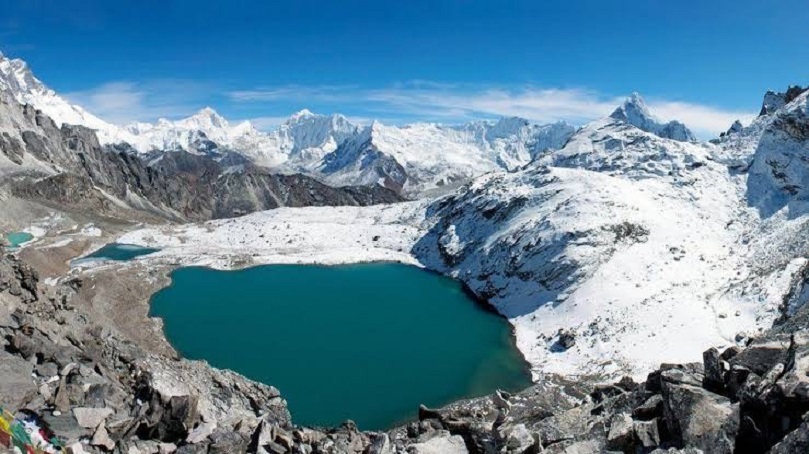
In the endless weaving of our world’s beautiful scenery, nothing could be more marvellous and magnificent than the heights of the Himalayas. This colossal mountain range, spanning several countries, is not just an astonishing scenic phenomenon but also key to balancing the natural world. The Himalayas, infamously considered the ‘roof of the world’, are becoming a pot that triggers many environmental disasters that have dangerous effects spreading to the entire world if the current situation continues.
Scientists and experts in climate and environment have issued statements, like blaring sirens, regarding the rapidly increasing influence of climate change in the Himalayan region. The retreat of glaciers, unusual fluctuations in weather patterns, and frequent manifestations of destructive natural phenomena are only a few examples of the visible results of this catastrophe. The fast melting of the area’s glaciers, which provide fresh water for millions of people, is severe. The overall impact of this melting is manifested not merely in the vicinity of the site but also by a gradual rise in sea levels and landmass erosion worldwide.
Besides deforestation, unsustainable tourism and industries seriously threaten the fragility of the Himalayan ecosystems. Moreover, the disappearing fragility of the region is not only declining its natural look but also eroding the region’s ability to control the climate and provide necessary ecosystem services.
The realisation and acceptance that nobody cares much about the problems of the Himalayas are uneasy and horrifying. However, the good part is that there is hope. Through the joint efforts of people, communities, and the government, various active measures can be taken in order to swing the tide on the current environmental crisis and continue to keep our planet alive at the same time.
However, one more priority in this process is to involve sustainable activities in our development projects in order to make sure economic growth does not come at the expense of environmental preservation. Thai authorities should enforce heavy regulations that punish deforestation, award renewable energy sources, and give tax incentives for sustainable tourism. By starting with investments in green technology and likewise creating environmental awareness in society, it would be feasible to manage the adverse effects of climate change in the Himalayan region.
The countries sharing the Himalayan habitat should collaborate in developing a shared path to environmental sustainability, disaster management, and climate resilience. By combining the efforts and skills of a number of countries, we will be able to jointly address the many-sided problems of climate change in the area.
Obviously, individual endeavours, too, assume a central position in combating the Himalayan predicament. Through implementing small lifestyle changes, including conserving energy use, recycling, and waste reduction, and practicing ethical consumption, every individual can make a remarkable contribution to the overall movement of environmental conservation. We need to educate ourselves and others on the significance of protecting the Himalayas and taking serious initiatives to reduce our ecological footprint. Regardless of the small steps we take, it makes a huge difference.
Besides that, funding and giving chances for small-scale initiatives and community-based conservation projects will definitely have a positive impact on the environment of the Himalayas. From tree planting drives to ecologically sound agriculture practices, the idea is to make ordinary citizens the main stakeholder in their ecosystems, which in turn ensures long-term sustainability.
To sum up, the Himalayas are revered for their aesthetic value, but recent trends indicate that they are under serious threat due to changes in climate and human activity. Yet the main solution is to take preventive measures at both the individual, community, and legislative levels, since otherwise the problem of ecological crisis will continue to exist, putting the whole planet at risk. The time to act is right now, and we all have our part to play in ensuring that the Himalayas do not experience further pollution and environmental degradation. With the challenge upfront, let us start and collectively go on a journey towards a sustainable and resilient future for all.
Views expressed in the article are the author’s own and do not necessarily represent the editorial stance of Kashmir Observer
- Sheikh Yameen is the CEO & Cofounder of Curve Electric, a startup working in the field of
- micromobility & can be reached at [email protected]
Follow this link to join our WhatsApp group: Join Now
Be Part of Quality Journalism |
Quality journalism takes a lot of time, money and hard work to produce and despite all the hardships we still do it. Our reporters and editors are working overtime in Kashmir and beyond to cover what you care about, break big stories, and expose injustices that can change lives. Today more people are reading Kashmir Observer than ever, but only a handful are paying while advertising revenues are falling fast. |
| ACT NOW |
| MONTHLY | Rs 100 | |
| YEARLY | Rs 1000 | |
| LIFETIME | Rs 10000 | |












